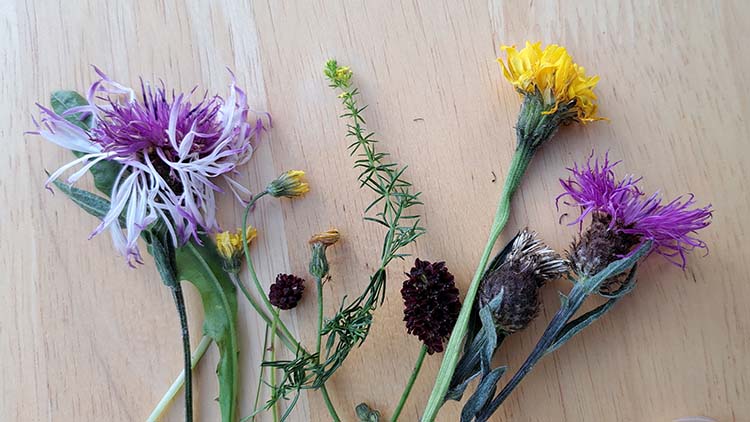Recent climatic extremes are rendering strict cutting dates far less useful within normal farming operations. In the past, farmers cut their hay according to the weather (3-4 dry days are needed to cut, turn, bale and store it) and when it was ready, using their own judgement rather than adhering to prescribed dates such as those applying to agri-environment support schemes like Countryside Stewardship. This year’s higher than average temperatures and rainfall has made finding an optimum time to cut more problematic than usual for many hay meadow managers, especially those who are dependent upon contractors.
At Clattinger Farm in Wiltshire, staff had luckily arranged for the meadows to be cut at the very start of July. The subsequent high rainfall and warmth resulted in a pretty spectacular second flowering, predominantly greater and common knapweed, saw-wort and Devil’s bit scabious, great burnet, yarrow and red clover. Cat's ear, rough and autumn hawkbits also flowered in profusion, extending the period when the meadows are extremely valuable to pollinating insects by a further 2-3 months. Bees and hoverflies in particular benefitted.
 Second flowering collected at Clattinger © Ann Skinner
Second flowering collected at Clattinger © Ann Skinner
By the end of September, it became apparent that the aftermath growth (of at least 10-12” sward height) was sufficient to warrant a second cut, carried out on 3rd October. Taking a second cut can be a useful tool for controlling coarse species that may be becoming dominant and reducing the thatch to allow space for more tender species to grow. It also has the added benefit of removing nutrients such as phosphate that can reduce botanical diversity if allowed to build up. However, there are also many practicalities for land manager to balance, including extra costs, contractor availability – and, of course, the weather! Three or four good sunny days are needed to dry and bale hay, so late cut crops may be wrapped as haylage instead.
Many agri-environment scheme agreements restrict hay cutting dates until after the mid-summer peak, which may have been appropriate when they were first introduced in the 1980s. Since then, the relationship between calendar date and thermal time (the rate at which heat builds each year) has advanced by about two weeks because of climate change, and plant growth has advanced with it. Calendar dates that restrict haymaking now fall later in the botanical growth cycle and may therefore be contributing to declining botanical diversity through changes in nutrient cycling. In short, greater flexibility is needed to work with increasingly variable conditions. Learn more about this with this 5-minute audio and the related blog post.
This year’s lush and nectar-laden aftermath at Clattinger contrasts with the drought resilience shown at Longmead after last year’s record-breaking UK heatwave as a beautiful demonstration of how floodplain meadows can respond to highly variable seasonal conditions. Whether the summer is warm and wet, or hot and dry, these meadows can provide an extended nectar season for our pollinators, along with a nutritious hay crop (possibly two) and many other ecosystem services, provided that the hay cut is timed to work with the natural growth cycle of plants.
 Second cut in progress at Clattinger © Ann Skinner
Second cut in progress at Clattinger © Ann Skinner